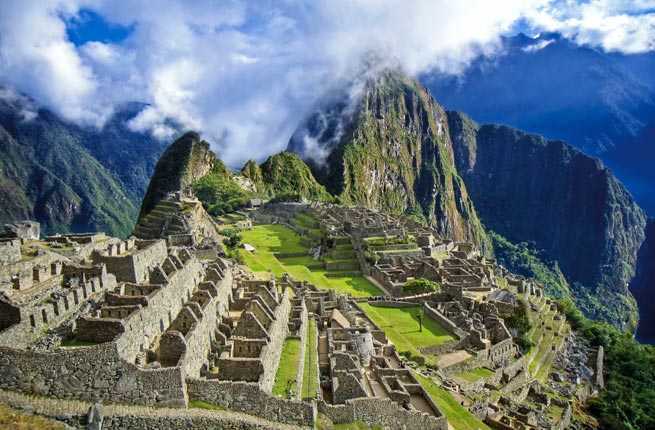
Maintaining a mysterious hold on travelers’ imaginations, Machu Picchu is a bucket-list destination that draws more than a million visitors each year. But the ancient citadel is just one of the many fascinating sites waiting to be explored in this part of Peru. If you’re planning to visit, set aside plenty of time to explore the nearby Sacred Valley as well as Cusco, the former capital of one of the greatest civilizations ever known. Keep in mind that most of your trip will be at elevations ranging from 8,000–12,000 feet, so allow for some time to acclimate to the thin air, if possible. Then, head to these ten spots you shouldn’t miss while exploring the wonders of the Inca Empire. —Deb Hopewell

Museo Larco
Nearly every flight from the U.S. arrives first in Lima, one of the few coastal capitals in South America. If you’re staying for a day or two before heading to Cusco and the Sacred Valley, make a point to visit the outstanding Museo Larco to see one of the largest private collections of pre-Columbian artifacts in the world. Set inside a beautifully landscaped eighteenth-century mansion (built over a seventh-century pyramid), the museum displays its ceramics, carvings, jewelry, gold, sacrificial relics, weapons, and other objects—around 50,000 in total—to illustrate how the Inca drew from thousands of years of other cultures to become one of the mightiest civilizations ever.
Insider Tip: Try to make time for a bite at the excellent Museo Larco Café, or at the very least, a Pisco Sour on the patio.
PLAN YOUR TRIP: Visit Fodor’s Lima Travel Guide

Historical Cusco
The city of Cusco, a UNESCO World Heritage Site in the Andes, was settled by indigenous people several centuries before the Inca arrived, but it was the latter group who made it their capital during their rule, from the thirteenth–sixteenth centuries. When the Spanish arrived, they set about destroying the holy city, but some of the remarkably built stone walls still remain, incorporated into other structures, like those of Qurikancha, the most important Inca temple. Known as the “sun temple,” its outside walls were covered in gold and silver, which were stripped by the conquistadors; large parts of those walls are still visible today as the foundation of the seventeenth-century Church of Santo Domingo, which is open to visitors and a highly recommended stop.
Insider Tip: For another perspective, a short taxi ride to the northern hill overlooking the city will bring you to Sacsahuaman, a sprawling complex of gigantic stones began believed to be both a ceremonial site and a fortress.
PLAN YOUR TRIP: Visit Fodor’s Cusco Travel Guide
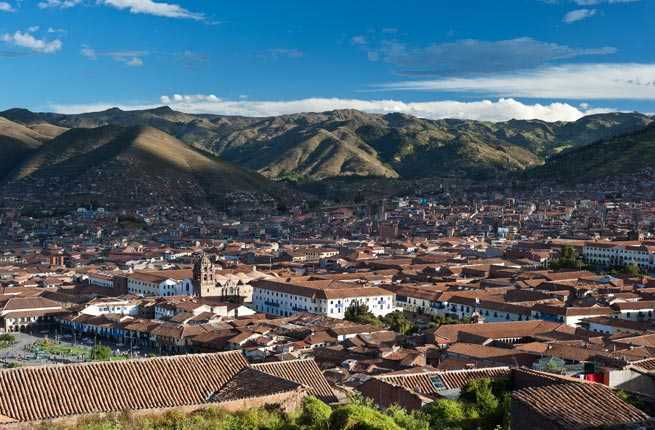
Contemporary Cusco
Today, Cusco is one of the fastest-growing cities in all of South America, thanks to its burgeoning tourism industry. There’s no lack of luxury hotels—the Aranwa Cusco, occupying a sixteenth-century colonial mansion, is one—and Andean-influenced fine-dining options like Incanto, located near Plaza de Armas, the main square. One thing you’ll notice is the abundance of colonial churches and cathedrals in the city center: The Spanish purposefully built their churches on top of any Incan structures they encountered. Spend some time wandering the old, narrow streets near Plaza de Armas, where vendors sell alpaca-wool sweaters and other woven goods at much lower prices than you’ll find at the upscale shops near the tourist attractions and nice hotels.
Insider Tip: Most likely you’ll arrive at Cusco from Lima, a difference of around 11,000 feet in elevation. Drink plenty of water and consider taking it very easy the first day.
PLAN YOUR TRIP: Visit Fodor’s Cusco Travel Guide

Pisac
Less than an hour northeast of Cusco, at the eastern mouth of the Sacred Valley, is the bustling town of Pisac, famous for both its impressive ruins above the village and the hugely popular market that’s open every day (it draws the largest crowds on Tuesdays, Thursdays, and especially Sundays). Bring cash in Peruvian soles and be prepared to bargain—it’s the accepted method of commerce here. From the marketplace, there’s a pathway that leads to the mountain and the beginning of the climb to the ruins at the top. It’s a long (two to three hours) and somewhat arduous hike up, but there’s a good alternative: Hire a taxi to take you around to the back side of the mountain, where a road leads to the top. Get dropped off there and then make your way through the ruins as you leisurely descend.;
Insider Tip: Pisac is best done as a day trip from Cusco or other towns farther down the Sacred Valley, as the hotel choices in Pisac are limited and not particularly great. You can take a taxi from Cusco for around $30 round-trip, or, even cheaper, a bus will get you there and back for under $5.
PLAN YOUR TRIP: Visit Fodor’s Pisac Travel Guide
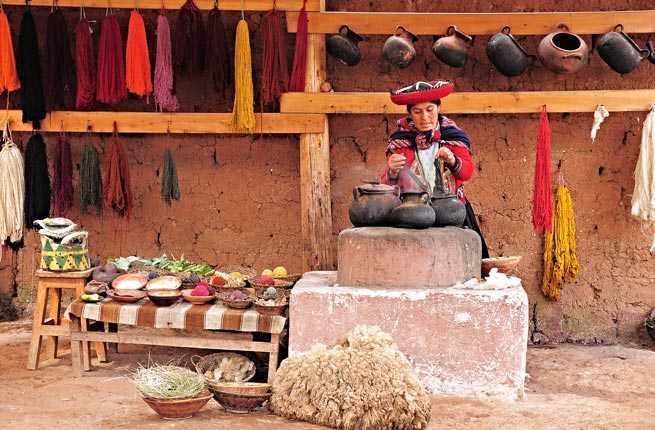
Chinchero
Halfway between the highlands and the Sacred Valley, less than 20 miles northwest of Cusco, lies Chinchero, a village seemingly untouched for centuries. The locals here hold steadfastly to their traditional clothing and customs, including the time-honored practices of alpaca-wool weaving, potato farming, and trueque (bartering for goods). At nearly 12,350 feet, you’re likely to feel the elevation as you climb the narrow streets toward the main plaza, built on the ruins of an ancient Incan palace, with a colonial Catholic church just above it and agricultural terraces spreading out below.
Insider Tip: The Sunday market is arguably the best in the area, but if your visit doesn’t coincide with Sunday, stop off at the women’s collective just below town, where they demonstrate every step of making alpaca-wool textiles, from spinning to dying to weaving, and where you can buy from them directly (and cheaply).
PLAN YOUR TRIP: Visit Fodor’s Chinchero Travel Guide

Huaypo Lake
Less than 45 minutes outside of Cusco and about five miles outside of Chinchero lies placid Huaypo Lake, located on a high plateau (nearly 11,500 feet) wreathed by rugged, low hills that give way in the distance to the Andes. The familiar terraces on one side of the lake are farmed by the local Quechuans, as they’ve done since the time of the Inca. Arrive in the morning at Piuray Outdoor Center for a limb-loosening, lakeside yoga session before grabbing an oar and launching your stand-up paddleboard for a quiet morning exploring the shoreline.
Insider Tip: The sunken Inca terraces at Moray are nearby, and worth a stop. These depressions, formed in concentric circles, can vary in temperature by as much as 25 degrees from top to bottom, and are thought to be the first “agricultural lab” for plant domestication and hybridization.
PLAN YOUR TRIP: Visit Fodor’s Sacred Valley Travel Guide
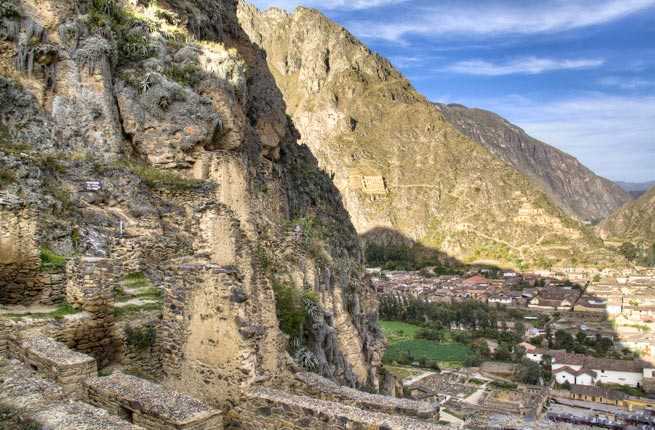
Ollantaytambo
This busy little village has been occupied continuously since the fifteenth century, a living example of Incan urban planning, with its neat grid of cobbled streets and water channels that are still in use today. At the western end of town is one of the best preserved Incan ruins in the valley, a fortress high atop the steep Temple Hill, with terraces spilling down to the town below.
Insider Tip: Ollantaytambo is the starting point for both hikers set on challenging the Inca Trail leading to Machu Picchu, and the trains that take passengers to the foot of the site, making it a convenient (and popular) stopping point, where you’ll find accommodations ranging from thrifty hostels to garden-like enclaves such as the Hotel Pakaritampu.
PLAN YOUR TRIP: Visit Fodor’s Ollantaytambo Travel Guide
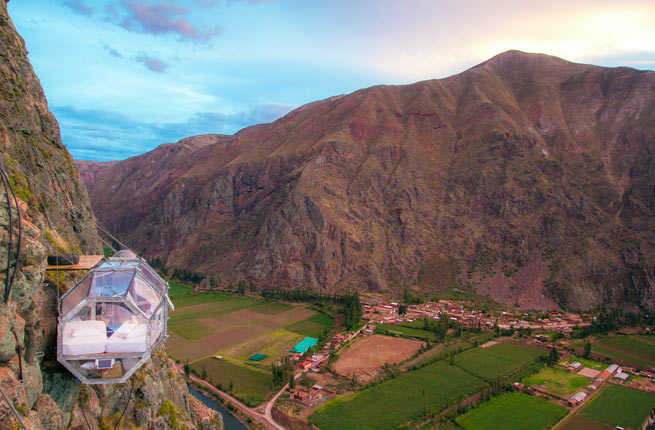
Skylodge Adventure Suites
Perched 1,200 feet up a cliff, halfway between Urubamba and Ollantaytambo, sits one of the most talked-about “extreme” lodgings to open in the past couple of years. Accommodations at Skylodge Adventure Suites (from $340 per person) consist of two see-through, egg-shaped polycarbonate “pods” (a third is used by the guides) that you get to by either scaling a near-vertical via ferrata or hiking a zigzag route along a zip line. Once at the top, you’re rewarded with sweeping condor’s-eye views of the river and valley below, and a canopy of stars at night. A gourmet dinner, including wine, is included; in the morning, you take the zip line down.
Insider Tip: Consider arranging your trip to Peru through a tour company such as Journeyou, because having a local, knowledgeable guide really adds richness and context to the experience.
PLAN YOUR TRIP: Visit Fodor’s Sacred Valley Travel Guide

Train to Machu Picchu
Even if there were another way to get to Machu Picchu other than hiking the grueling Inca Trail (there isn’t), you wouldn’t want to skip the seventeen-mile, 105-minute train ride from Ollantaytambo, along the Urubamba River, to Aguas Calientes, the village at the bottom of the mountain that serves as gateway to the ancient site. Both Inca Rail and Peru Rail have economy-class trains that travel the route, but if you can spend the extra cash on Peru Rail’s Vistadome train, at least on the way there, it’s worth it: The domed roof windows allow for incredible mountain views as you journey through the valley, including 18,700-foot Mount Veronica. After an hour or so, the semi-arid habitat of the low highlands gives way to cloud forest, where dense mist swirls over the steep peaks and the lush forest hints at the wonder just beyond.
Insider Tip: Book a seat on the left-hand side of the train for best views on the way to Machu Picchu, and on the right-hand side for the return trip.
PLAN YOUR TRIP: Visit Fodor’s Machu Picchu and the Inca Trail Travel Guide

Machu Picchu
This architectural marvel, one of the New Seven Wonders of the World, needs little introduction. Since it was “discovered” by Yale University lecturer Hiram Bingham in 1911—after lying hidden, untouched, for centuries—Machu Picchu has captured the world’s imagination as science continues to reveal the astounding accomplishments of the Inca. Nearly every stone in the vast complex was set with purpose, arrayed to reveal astronomical phenomena with the passing of the sun, to build a sophisticated water system, or form a sacred representation. The expansive terraces not only provided more area for farming crops, but acted as a drainage system. At its zenith, Machu Picchu was probably home to 500–1,000 Incan royalty and lower-class caretakers, before it was abandoned in the sixteenth century, barely 100 years after it was built.
Insider Tip: The number of visitors is limited to 2,500 a day, so buying a ticket in advance is critical; if you’re not going through a tour operator, you’ll need to buy your tickets weeks in advance so they’re not sold out for the time you want to visit (and tickets are not sold at the site). You’ll pay a hefty add-on fee to the $45 ticket if you go through a third-party site to book your tickets, so go directly to the country’s Ministerio de Cultura website to book yourself. Note that while the website has an English-language mirror site, you can only book them on the Spanish-language site.
PLAN YOUR TRIP: Visit Fodor’s Machu Picchu and the Inca Trail Travel Guide



